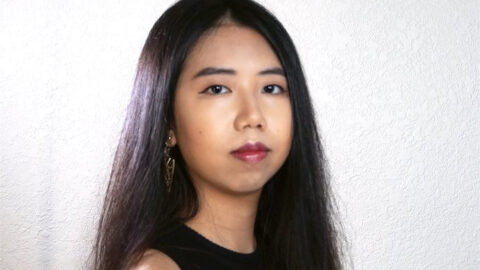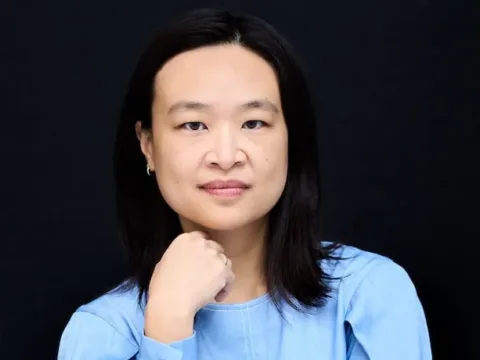New Arts Collaboration (NAC), founded by pianist Ting Luo, is dedicated to bringing artists together and fostering space for collaboration. Works have been selected and featured in The Saint Luis Obispo Museum of Art’s Digital Shorts Film Festival, Fresh Inc Festival, New Music Gathering, and Thailand New Music and Arts Symposium, to name a few. On November 7, 2021 at 4pm, NAC will present “POETIC MOVE,” a concert of music for visual/multimedia works with piano music by living composers at Old First Concerts in San Francisco. The concert is also accessible via livestream.
Why do multimedia works/collaborations appeal to you?
First of all, I enjoy collaboration, especially collaborating with people with creative minds, exchanging ideas, and curating something that has never been seen before or hasn’t been explored to some extent. I am drawn to various art forms, including visual art, dance, theatre, and sound art, and the idea of curating works that combine these distinguishably different forms of arts is very appealing to me. Being a classically trained pianist for more than twenty years, I have spent the majority of my time studying existing repertoire and training my piano technique to perfection rather than creating new works and engaging with voices that speak for myself and the community of people around me.
NAC is an exciting project that allows me to work with other wonderful artists. The experience of being both the pianist and the director of the project — performing and leading the executive and artistic direction — has been challenging and rewarding. I believe that in a true collaboration, each of us makes a small contribution, and the final product ends up being far beyond what any of us could have achieved individually.
On the other hand, my initial thought for this project was to create a space that used immersive sound and visuals. I imagined it could be a virtual space or a physical space containing a number of sonic components for listening and concrete materials for visualization and sensation. So the multimedia piano concert was the first step toward realizing this vision. Inspired by walking through immersive installations such as Infinity Mirror Rooms by Yayoi Kusama and Rain Room by Random International, I found myself wondering about the interactions between human beings, nature, technology, and the environment. It is fascinating for me to see objects in daily life rearranged and re-created in art installations.
In commissioning works for NAC, I asked the composers to observe daily objects and sounds. Composer Julie Barwick incorporated the small daily sounds of housework in her piece Around. Danny Clay and I made video and audio recordings of random and quirky found objects and created interesting collages in his composition.
Are there any conceptual themes that shaped “POETIC MOVE?”
The title for the concert is two-fold: poetry and movement. There are a few pieces that are inspired by poetry. I didn’t assign the composers a theme for their works, but I realized there were four pieces related to poems when I finalized the pieces. In WORDS, a multimedia piano composition by Belinda Reynolds, I wrote a poem about my grandfather’s life as a composer in China. Belinda asked me to record the poem in Chinese mandarin, and she made sound collages in her composition that blend the piano music and my voice, resulting in a beautiful mixture of sound and language.
Other pieces including How Deep is the Valley by Brett Austin Eastman, Cornkind by Christopher Cerrone, and FOOTSTEPS by Jean Ahn are also inspired by poems from various cultures and languages.
The second word, “MOVE,” is from my personal understanding of piano performance. For me, piano performance is not only about the physical technique of playing the piano, but the entire motion of performing, which has its own tempo and spirit and could be an art form itself. There is a choreography of piano performing that allows pianists to express themselves freely and fearlessly with their hands and bodies. Together, these two concepts have formed the concert title, “POETIC MOVE.”
What do some of the multimedia collaborations look like on POETIC MOVE? For example, in what ways are visual arts used in different works?
In the collaboration this year, visual artists are working with the composers to create unique visuals for each composition. We have decided to have the visuals shown on a screen simultaneously with the live piano performance. For the practical process of creating each multimedia work, the participating visual artists, composers, and I held discussions through virtual meetings to make sure each component had its own unique character, but that the music and visuals also came together as a whole.
Besides visuals, all of the compositions also contain more than one medium, such as electronics, fixed media, tape, and interactive media. It is going to be an experimental event, with all of the piano pieces being performed live with electronics that have been produced by different methods by each composer. In my composition, Hypothesis, I combined field recordings with electronics to create an experience of “being in the moment.” In one of the movements, “Shudder,” the majority of the sound is demolition. In the second movement, “Breath,” there are sounds made from the motion of found objects. I always enjoy making field recordings, revisiting and editing them.
My collaborator, visual artist Loraine Wible, made a special scene for each piece. For example, in “Breath,” Loraine recorded herself standing and breathing for the entire duration of the movement. The final video with visual effects is calm yet interesting. People can no longer see Loraine herself, but see transformed images of her in a dreamlike darkness with flowing bubbles. From the piece and the visual, I’d like to let people think about larger concepts, such as emptiness, dreams, and isolation, to name a few.
What does New Arts Collaboration look for in potential collaborators?
New Arts Collaboration starts from the word “New,” which defines our core value as being experimental without boundaries when it comes to artistic explorations. Besides connecting artists from various backgrounds and presenting collaborative works, sound and multimedia are essential parts of the NAC mission. As the director and a pianist myself, I am trying to carry my passion for piano performing into the project to expand and explore new piano works that line up with the project’s vision.
We have formed a wonderful artist lineup for this year’s premiere concert. After the concert on November 7, I am also open to accepting proposals and working with other artists whose work reflects the direction of NAC. Potential collaborators can submit a proposal on NAC website, entering their artistic background and work samples, and I will follow-up with questions or to schedule a Zoom call for further conversations. NAC looks for artist collaborators that are interested in creating original works in the fields of sound art, composition, improvisation, visual arts, and more. Collaborators who are passionate, curious, open-minded, and committed to collaboration and teamwork would be a great fit for future NAC collaborations.
We are not creating visuals or other elements to simply accompany the music — we are creating interdisciplinary works that can be appreciated as a whole.
What can we look forward to from New Arts Collaboration in the future?
NAC will continue its mission of collaborating with artists and creating works with fellow collaborators. NAC is not only aiming to present multimedia concerts for new music and visual arts in traditional concert venues, but also intends to expand the possibilities of form and context in the future. Maybe we could present in museums and galleries where the visuals are on display. Maybe there could be installations and other types of performing arts with sound and music. With technology being so heavily applied in the music industry, how can we incorporate it to make a better audio and visual experience?
In April, NAC presented “Snow,” one of the movements from the suite FOOTSTEPS by Jean Ahn with visuals by Jo Ho, in The San Luis Obispo Museum of Art’s Digital Shorts Film Festival. It was an honor to be featured at this high-calibre event of experimental short films and digital arts. The audience was impressed by the combination of visuals and music since Jo made a beautiful cinematic video with the composition. For the premiere this month, I am super excited to perform the other movement from the suite, “Mars.” Jo has created the video using machine-learned visuals trained from data sets of images of planets.
For future collaborations, I would like to keep up the mindset that each artist’s contribution is of equal value. We are not creating visuals or other elements to simply accompany the music — we are creating interdisciplinary works that can be appreciated as a whole.
I am happy to see that NAC has already grown. Works by NAC were presented at the 2021 New Music Gathering this past August, and we will be showcased in an audiovisual exhibition at the Thailand New Music and Arts Symposium (TNMAS) this December. There will be a video showcase featuring the multimedia works by our collaborators, with the festival theme being “Hybrid World, Cultural Reconnection.” Speaking to this theme, NAC is driven by collaborators from diverse backgrounds and cultures, and most of the works are completed through virtual collaboration with artists from the U.S., Singapore, and Germany. I knew that TNMAS is dedicated to presenting works for new art and new music around the world, and I am delighted that NAC is participating in such an internationally recognized event.
I CARE IF YOU LISTEN is an editorially-independent program of the American Composers Forum, funded with generous donor and institutional support. Opinions expressed are solely those of the author and may not represent the views of ICIYL or ACF.
A gift to ACF helps support the work of ICIYL. For more on ACF, visit the “At ACF” section or composersforum.org.
























